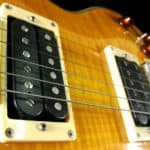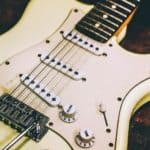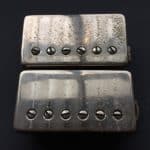Breaking news: Most guitars have multiple pickups.
I know this might shock you, but let’s settle down and talk it out.
We all know that this common feature has a reason. Pickups placed in different parts of the string will get your alternative tones.
And yes, you can also have different pickups per se, but placement is the biggest sound definer.
The big issue for many players, then, is knowing when to use each of these positions.
To make it short, a practical rule of thumb would be the following:
Bridge pickups get you a twangy and trebly tone that works great for aggressive riffs and solos. Neck pickups sound round, dark, and bassy and are great for melodic leads, plus they have the highest output. Middle pickups don’t have a defined character but work great when you just need to blend in.
If you want to know more about this, I’d recommend you stick with me for a bit longer.
In this article, I will tell you all you need to know about when to use each pickup position.
After leaving this page you will have a clear idea about their different sounds and how you can apply them to your music.
Are you ready to get started?
Let’s go!
What’s the point of guitars having multiple pickups?
Electric guitars started as a necessity. Acoustic instruments just started being too troublesome to amplify when playing live.
When the electric guitar pickup was introduced, it was considered just a means of electrifying the acoustic signal.
With time, manufacturers discovered that it could also be a means to shape the resulting tone of the instrument.
Guitar strings vibrate differently along their length, so, naturally, placing pickups in different positions will get you slightly alternative sounds.
So, having multiple pickups on a guitar will give you different voices at just the flick of a switch.
Is then having more pickups on a guitar definitely better then?
Well, it’s hard to say. I discuss that in the following article:
How often do guitar players switch between pickups?
Not all players are the same, and some can get very crazy with their switches, while others never even touch them for hours while playing.
In general, I would say that most players switch between pickups for different parts of a song, or for certain changes in the mood of what they are playing.
They might feel like they need a more smooth tone for a rhythm section and a more aggressive one for the following lead.
The reality is that when you know what your guitar is capable of, and you think critically about how it fits with your music, switching pickups becomes a necessity.
It is very rare, on the other hand, to see players flicking switches every 2 or 3 notes, but I can imagine someone switching pickups between licks of the same solo.
When to use the bridge pickup?
The bridge pickup has a very particular tone that many players love, and many others hate.
It’s the twangiest of them all, and although, because of its position, it’s not the one with the most output, due to its presence and trebly tone, it reads overdrives and distortions amazingly.
Most players go for the bridge pickup when they need an aggressive sound or something that cuts through the mix.
It’s perfect for soloing and playing riffs or licks where the guitar should be the main focus.
When to use the middle pickup?
The middle pickup, when available, is usually the least used.
It’s somewhat hard to know for certain when it’s needed since its sound is not as defined as both the neck and the bridge positions.
The best use case for the middle pickup, in my opinion, is when you just need to blend with the background, or even when you have something apathetic to say.
Its complexity goes beyond the scope of this single article, and I have written another one focused exclusively on this pickup and its uses.
You shouldn’t stress too much if you can’t find a place for it in your music, however, I encourage you to give it a try.
It might be what you were looking for all along without even knowing it.
When to use the neck pickup?
The neck pickup is many players’ favorite.
With it, you get the most output, because of where it lays, and a rounded, darker and smooth tone.
It’s usually chosen for playing lead melodies and sounds great with clean tones as a way to compensate for the natural harshness of the electric guitar.
Although its bassier sound doesn’t cut as well as the bridge pickup, its extra output more than compensates for it, and when you use it your guitar will sound with an added authority that will shift the focus towards you.
During solos, it’s nice to mix some neck pickup licks with more aggressive bridge pickup ones to keep the audience on the edge of their seats.
When to use pickup combinations?
Finally, pickup combinations are another fundamental tool for modern guitar players.
With them, you get extra voices to add to your toolbox, and I wouldn’t consider them as just a blend of other sounds.
Pickup combinations have their own character.
And this is particularly true for 3 pickup guitars such as Stratocasters.
When combining the bridge and middle pickup, you get a trebly nasal tone, but without the extreme harshness that the standalone bridge pickup brings to the table.
It’s great for funky and/or rhythmically present parts.
The middle and neck pickup combination works in a similar fashion, you also get a thinner sound, but with some reminiscence from the roundness and brassiness from the neck pickup.
You will find yourself using it a lot also for rhythm work, but with a mellower outcome.
In the case of 2 pickup guitars, the only combination available will get you something like a middle pickup.
Its character is not clearly defined, but it sounds full and can work for many things.
Personally, I think it shines for cleaner or slightly overdriven tones, but you should do your own experimentation paying close attention to the sounds you get.

Hello there, my name is Ramiro and I’ve been playing guitar for almost 20 years. I’m obsessed with everything gear-related and I thought it might be worth sharing it. From guitars, pedals, amps, and synths to studio gear and production tips, I hope you find what I post here useful, and I’ll try my best to keep it entertaining also.





